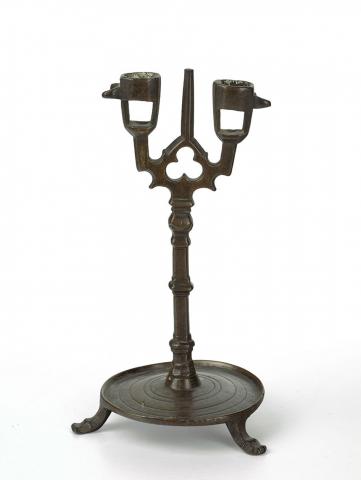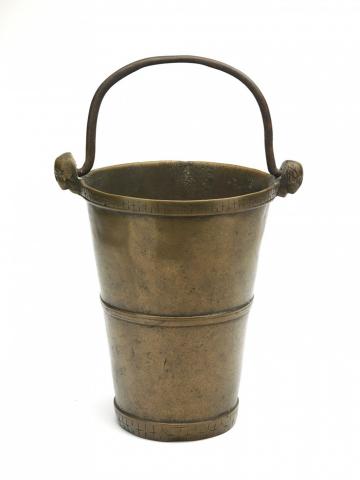3. The Facts
In this procedure the Committee based its considerations on the following facts.
3.1 Emanuel Vita Israël, the son of a diamond dealer, was born on 21 February 1873. From 1896 Vita Israël ran a pharmacy at Muiderstraat 14 in Amsterdam. Vita Israël married Leonore Fanny Frederika Jacobs (1873-1943, hereinafter also referred to as Leonore Jacobs) in 1902 after making a prenuptial agreement. The couple had two sons. In 1938 the older son, Joost Vita Israël (1903-1944) married Catharine Magdalena Frederika Borghmans (1904-1998, hereinafter also referred to as Catharine Borghmans) in community of property. They had two daughters, CC (born in 1939, one of the Applicants) and Jacqueline Charlotte (1940-1973). In 1934 the younger son, Gerrardus Vita Israël (1905-1943) married Esther van Gelder (1899-1943) in community of property. This couple had no children.
Vita Israël committed suicide on 15 May 1940, shortly after the German invasion. The only members of his family to survive the war were Catharine Borghmans, who was not of Jewish descent, and both her daughters. Leonore Jacobs was interned in Westerbork transit camp on 19 May 1943. This was followed on 1 June 1943 by deportation to Sobibor, where she was murdered on or around 4 June 1943. Joost Vita Israël was interned in Westerbork transit camp during a period in the spring and summer of 1943 and died from meningitis in Amsterdam on 13 February 1944. Gerrardus Vita Israël and his wife Esther van Gelder were interned in Westerbork transit camp on 26 May 1943. On 8 June 1943 the couple were deported to Sobibor, where they were murdered on or around 11 June 1943.
3.2 Vita Israël was a passionate art lover and had a collection of paintings and antiquities, to which he gave members of the public access in period rooms in his home above the pharmacy. He also had a collection of Judaica, items from which he lent for exhibitions staged by the Genootschap voor de Joodsche Wetenschap in Nederland. Vita Israël played an important part in the Portuguese-Jewish Congregation. He was one of the founders of the Jewish Historical Museum (JHM), which opened in 1932 and to which he lent various items from his collection.
In a will drawn up on 30 June 1939 before S. Teixeira de Mattos, at the time a notary in Amsterdam, Vita Israël revoked all previous wills made by him. In the will concerned he bequeathed a life interest in one third of his estate to his wife and he appointed his two sons as his only beneficiaries. Vita Israël stipulated that his collection of antiquities had to be auctioned off within six months of his death.
‘Tenslotte heeft de testateur verklaard aan zijn erfgenamen, aan de vruchtgebruikster en aan den of de in functie zijnde(n) uitvoerder of uitvoerster zijner uiterste wilsbeschikkingen de uitdrukkelijke verplichting op te leggen, om de tot zijn nalatenschap behoorende antiquiteiten binnen zes maanden na zijn overlijden in publieke veiling te verkoopen’
[‘Finally the testator declared to his beneficiaries, to the usufructuary and to the executor or executrix, or the person in the capacity thereof, of his last will that he imposes the express obligation to sell at public auction the antiquities belonging to his estate within six months after his death.’]
There is no comparable provision in his previous wills.
3.3 After Vita Israël’s death on 15 May 1940, on 10 June 1940 the dealer J.A. van Bever prepared a private valuation report of the movable goods belonging to his estate. Among other things, this report provides an overview of the antiquities in the premises at Muiderstraat 14 and 16 in Amsterdam. The report lists among other things two antique bronze situlas and various antique bronze candle sticks and candelabra, but contains no illustrations.
In accordance with the aforementioned testamentary provision, Vita Israël’s antiquities, with a few exceptions, were sold at auction within six months of his death. Between 5 and 7 November 1940, 445 lots from this collection went under the hammer at auctioneers Frederik Muller & Co. The description of lot number 196 in the sale catalogue is as follows:
‘196 Ronde bronzen wijwater-emmer naar onderen smal toeloopend met 2 randen, voorzien van een kruismotief, het gesmeed ijzeren hengsel gevat in twee engelenkopjes. – XVIe eeuw – Hoog 23.5 cent.’
[‘196 Circular bronze situla tapering downwards with two bands, bearing a cross motif, the forged iron handle is held in two cherub heads. – 16th century – Height 23.5 cm.’]
Lot number 198 is described as follows:
‘198 Gothische bronzen tweearmige kandelaar op ronden voet met drie pootjes. Bruine patine. – Xve eeuw. – Hoog 22 cent.
Zie de afbeelding.’
[‘198 Gothic bronze two-branched candelabrum on a round base with three feet. Brown patina. – 15th century – Height 22 cm.
See the illustration.’]
As stated in the description, the sale catalogue contains an illustration of the candelabrum.
According to the City Council, the currently claimed candelabrum can be seen in a photograph of the interior van Vita Israël’s home in Amsterdam. The photograph, which is from the Amsterdam City Archives, was submitted by the City Council.
3.4 The currently claimed bronze situla and bronze candelabrum were given to the City Council in 1994 by Edith Frederiks (1923-2012) as part of the collection of her father J.W. Frederiks (1889-1962; hereinafter referred to as Frederiks). The two objects have been on loan to the Museum since 1968. The situla’s inventory number is ‘KB 78’ and that of the candelabrum is ‘KA 118’. The City Council submitted copies of the inventory cards drawn up by the Museum for both objects. Both inventory cards give (‘Eig.’) ‘Coll. Frederiks’ [(‘Owner’) Frederiks Collection] as the owner and there is a reference under the heading ‘Literatuur’ [‘Literature’] to a Frederik Muller sale catalogue of November 1940, lot numbers 196 and 198. The provenance given on the candelabrum’s inventory card is: ‘Afkomstig: verz. E. Vita Israels, Amsterdam’. [‘Origin: E. Vita Israel Collection, Amsterdam’.] The provenance given on the situla’s inventory card is: ‘Verz. E. Vita Israel, Amsterdam. Gekocht: Amsterdam nov. 1940’ [‘E. Vita Israel Collection, Amsterdam’. Purchased: Amsterdam November 1940’]. There is a handwritten note ‘60/290 Frederiks’ in front of lot number 198 in a copy of the sale catalogue submitted by the City Council. There is a handwritten note ‘Fred’ between lots numbers 196 and 197.
The Museum researched the provenance of both objects in the context of the investigation conducted under the auspices of the Netherlands Museums Association into museum collections in connection with looting, confiscation or forced sale during the 1933-1945 period. In 2018 the results prompted the Museum to contact the Applicants’ lawyer. Both objects are referred to in the publication ‘Omstreden verleden. Museum Boijmans Van Beuningen en de Tweede Wereldoorlog’ [‘A Controversial Past: Museum Boijmans Van Beuningen and the Second World War’] (2018).
3.5 No indications were found that the Vita Israël family made efforts after the war to regain possession of the artworks sold at auction at Frederik Muller & Co. in November 1940, or to obtain compensation for the loss of their possession. In so far as it has been possible to check, no objects were registered as missing by the family or its representatives with the Stichting Nederlands Kunstbezit (Netherlands Art Property Foundation, SNK). There is no management file relating to the Vita Israël family in the SNK archive.
However, in 2001 and 2007 items from two Dutch museums, the aforementioned JHM and the Gemeentemuseum Den Haag (GMDH, currently called the Kunstmuseum Den Haag), were handed over to the Vita Israël family. The transfer by the JHM concerned items that Vita Israël had loaned this museum before the war. CC had approached the JHM about them in 1998 and, after archival research by the JHM, fifteen objects were handed over to the Vita Israël family in 2001. The objects were bought back in 2002.
The handover by the GMDH concerned three artworks that this museum had purchased at the sale of the Vita Israël collection at auctioneers Frederik Muller & Co. in November 1940.
On 20 July 2015 the Committee issued a binding opinion in a dispute between the heirs of Vita Israël and Nijmegen City Council (RC 3.135). This opinion concerned the painting The Riddle of Nijmegen by Christiaen Coeuershof, which came from Vita Israël’s collection and which was sold by auction in November 1940 at Frederik Muller & Co. In this opinion the Committee came to the conclusion that the loss of possession of this painting could be designated as involuntary, caused by circumstances directly related to the Nazi regime. After weighing up the interests of the parties involved, the Committee then recommended restitution of the painting to the Applicants in that case.
3.6 An article by the journalist Lien Heyting in the NRC Handelsblad newspaper on 4 July 2008 addressed, among other things, the fate of the Vita Israël Collection. The following was stated about the proceeds of the auction.
‘In november 1940, kort na zijn zelfmoord, werd de ‘Verzameling van wijlen E. Vita Israël’, 440 lotnummers, in Amsterdam geveild. De Nederlandse kunsthandel verkeerde eind jaren dertig in een malaise, maar meteen na de Duitse bezetting kwam er uit Duitsland veel vraag naar oude Hollandse meesters. Dus bloeide die handel op en stegen de prijzen. Aan het begin van de oorlog werden de bezittingen van de Joden nog niet in beslag genomen. De opbrengst van de veiling, die niet tegenviel, ging naar de familie en kwam uiteindelijk terecht bij de niet-Joodse schoondochter die na de oorlog met haar twee dochtertjes overleefde. “CC heeft me vroeger verteld dat het gezin daar in haar jeugd goed van heeft kunnen leven”, zegt BB nu‘.
[‘In November 1940, shortly after his suicide, the “Collection of the late E. Vita Israël”, comprising 440 lots, was sold at auction in Amsterdam. At the end of the nineteen-thirties the Dutch art trade was in the doldrums, but immediately after the start of the German occupation there was substantial demand from Germany for Dutch Old Master paintings. So the trade flourished and prices rose. At the beginning of the war the possessions of the Jews had not yet been seized. The proceeds of the auction, which were not disappointing, went to the family and ultimately ended up with the non-Jewish daughter-in-law, who—together with her two small daughters—survived the war. “CC told me in the past that when she was young the family could live well on them,” says BB now.’ ]
In RC 3.135 the Committee conducted additional research into the fate of the proceeds of the sale and came to the conclusion it cannot be established with certainty what happened to them.

